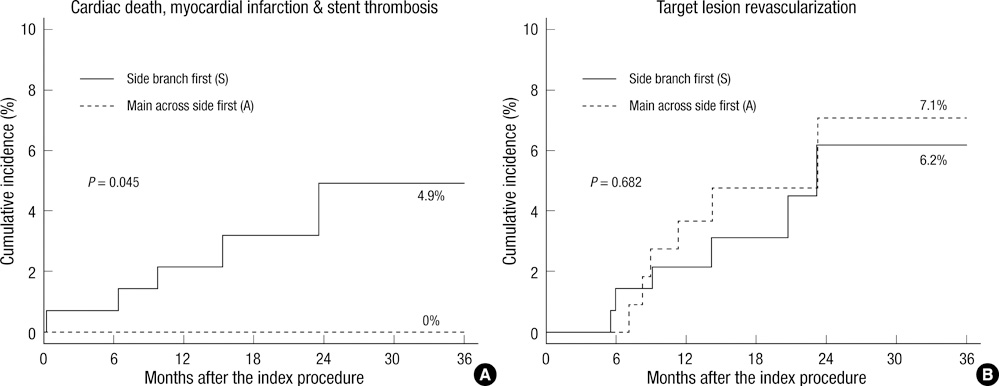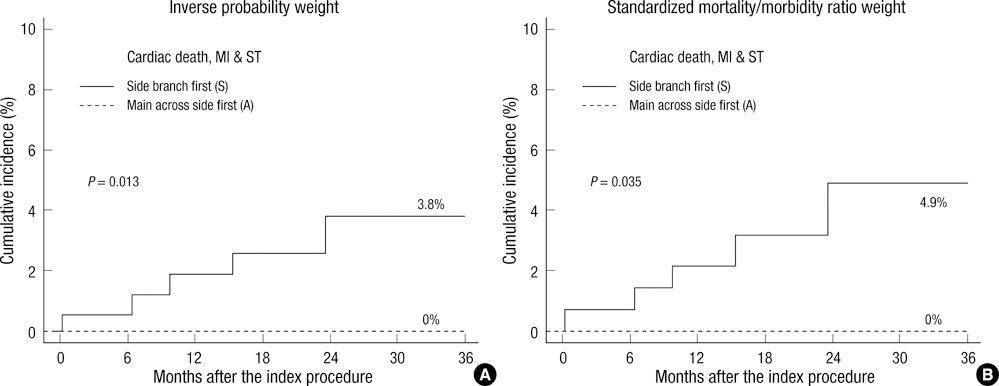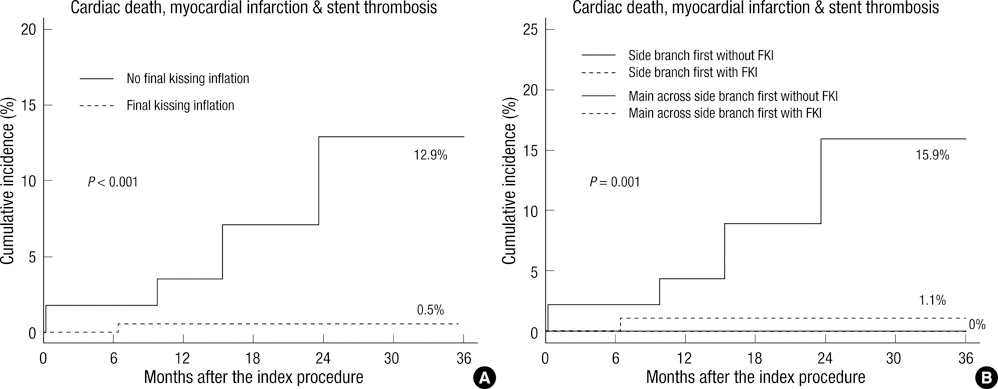J Korean Med Sci.
2011 Aug;26(8):1031-1040. 10.3346/jkms.2011.26.8.1031.
Comparing Two-Stent Strategies for Bifurcation Coronary Lesions: Which Vessel Should be Stented First, the Main Vessel or the Side Branch?
- Affiliations
-
- 1Department of Internal Medicine, Cardiovascular Center, Seoul National University Hospital, Seoul, Korea. hyosoo@snu.ac.kr
- 2Department of Internal Medicine, Boramae Medical Center, Seoul, Korea.
- 3Department of Internal Medicine, Samsung Medical Center, Seoul, Korea.
- 4Department of Internal Medicine, Chonnam National University Hospital, Gwangju, Korea.
- 5Department of Internal Medicine, Chungnam National University Hospital, Daejeon, Korea.
- 6Department of Internal Medicine, Korea University Medical Center, Seoul, Korea.
- 7Department of Internal Medicine, National Health Insurance Corporation Ilsan Hospital, Goyang, Korea.
- 8Department of Internal Medicine, University of Ulsan Asan Medical Center, Seoul, Korea.
- 9Department of Internal Medicine, Wonju Christian Hospital, Wonju, Korea.
- 10Department of Internal Medicine, Hallym University Kangdong Sacred Heart Hospital, Seoul, Korea.
- 11Department of Internal Medicine, Yeungnam University Medical Center, Daegu, Korea.
- 12Department of Internal Medicine, Keimyung University Dongsan Medical Center, Daegu, Korea.
- 13Department of Internal Medicine, Ajou Univeristy Hospital, Suwon, Korea.
- KMID: 1777841
- DOI: http://doi.org/10.3346/jkms.2011.26.8.1031
Abstract
- This study compared two-stent strategies for treatment of bifurcation lesions by stenting order, 'main across side first (A-family)' vs 'side branch first (S-family). The study population was patients from 16 centers in Korea who underwent drug eluting stent implantation with two-stent strategy (A-family:109, S-family:140 patients). The endpoints were cardiac death, myocardial infarction (MI), stent thrombosis (ST), and target lesion revascularization (TLR) during 3 years. During 440.8 person-years (median 20.2 months), there was 1 cardiac death, 4 MIs (including 2 STs), and 12 TLRs. Cumulative incidence of cardiac death, MI and ST was lower in A-family (0% in A-family vs 4.9% in S-family, P = 0.045). However, TLR rates were not different between the two groups (7.1% vs 6.2%, P = 0.682). Final kissing inflation (FKI) was a predictor of the hard-endpoint (hazard ratio 0.061; 95% CI 0.007-0.547, P = 0.013), but was not a predictor of TLR. The incidence of hard-endpoint of S-family with FKI was comparable to A-family, whereas S-family without FKI showed the poorest prognosis (1.1% vs 15.9%, retrospectively; P = 0.011). In conclusion, 'A-family' seems preferable to 'S-family' if both approaches are feasible. When two-stent strategy is used, every effort should be made to perform FKI, especially in 'S-family'.
Keyword
MeSH Terms
Figure
Reference
-
1. Ge L, Tsagalou E, Iakovou I, Sangiorgi GM, Corvaja N, Airoldi F, Chieffo A, Montorfano M, Michev I, Colombo A. In-hospital and nine-month outcome of treatment of coronary bifurcational lesions with sirolimuseluting stent. Am J Cardiol. 2005. 95:757–760.2. Thuesen L, Kelbaek H, Kløvgaard L, Helqvist S, Jørgensen E, Aljabbari S, Krusell LR, Jensen GV, Bøtker HE, Saunamäki K, Lassen JF, van Weert A. Comparison of sirolimus-eluting and bare metal stents in coronary bifurcation lesions: subgroup analysis of the Stenting Coronary Arteries in Non-Stress/Benestent Disease Trial (SCANDSTENT). Am Heart J. 2006. 152:1140–1145.3. Latib A, Colombo A, Sangiorgi GM. Bifurcation stenting: current strategies and new devices. Heart. 2009. 95:495–504.4. Pan M, de Lezo JS, Medina A, Romero M, Segura J, Pavlovic D, Delgado A, Ojeda S, Melián F, Herrador J, Ureña I, Burgos L. Rapamycin-eluting stents for the treatment of bifurcated coronary lesions: a randomized comparison of a simple versus complex strategy. Am Heart J. 2004. 148:857–864.5. Colombo A, Moses JW, Morice MC, Ludwig J, Holmes DR Jr, Spanos V, Louvard Y, Desmedt B, Di Mario C, Leon MB. Randomized study to evaluate sirolimus-eluting stents implanted at coronary bifurcation lesions. Circulation. 2004. 109:1244–1249.6. Steigen TK, Maeng M, Wiseth R, Erglis A, Kumsars I, Narbute I, Gunnes P, Mannsverk J, Meyerdierks O, Rotevatn S, Niemelä M, Kervinen K, Jensen JS, Galløe A, Nikus K, Vikman S, Ravkilde J, James S, Aarøe J, Ylitalo A, Helqvist S, Sjögren I, Thayssen P, Virtanen K, Puhakka M, Airaksinen J, Lassen JF, Thuesen L. Randomized study on simple versus complex stenting of coronary artery bifurcation lesions: the Nordic bifurcation study. Circulation. 2006. 114:1955–1961.7. Ferenc M, Gick M, Kienzle RP, Bestehorn HP, Werner KD, Comberg T, Kuebler P, Büttner HJ, Neumann FJ. Randomized trial on routine vs. provisional T-stenting in the treatment of de novo coronary bifurcation lesions. Eur Heart J. 2008. 29:2859–2867.8. Colombo A, Bramucci E, Saccà S, Violini R, Lettieri C, Zanini R, Sheiban I, Paloscia L, Grube E, Schofer J, Bolognese L, Orlandi M, Niccoli G, Latib A, Airoldi F. Randomized study of the crush technique versus provisional side-branch stenting in true coronary bifurcations: the CACTUS (Coronary Bifurcations: Application of the Crushing Technique Using Sirolimus-Eluting Stents) Study. Circulation. 2009. 119:71–78.9. Tsuchida K, Colombo A, Lefèvre T, Oldroyd KG, Guetta V, Guagliumi G, von Scheidt W, Ruzyllo W, Hamm CW, Bressers M, Stoll HP, Wittebols K, Donohoe DJ, Serruys PW. The clinical outcome of percutaneous treatment of bifurcation lesions in multivessel coronary artery disease with the sirolimus-eluting stent: insights from the Arterial Revascularization Therapies Study part II (ARTS II). Eur Heart J. 2007. 28:433–442.10. Gao Z, Yang YJ, Gao RL. Comparative study of simple versus complex stenting of coronary artery bifurcation lesions in daily practice in Chinese patients. Clin Cardiol. 2008. 31:317–322.11. Louvard Y, Thomas M, Dzavik V, Hildick-Smith D, Galassi AR, Pan M, Burzotta F, Zelizko M, Dudek D, Ludman P, Sheiban I, Lassen JF, Darremont O, Kastrati A, Ludwig J, Iakovou I, Brunel P, Lansky AJ, Meerkin D, Legrand V, Medina A, Lefevre T. Classification of coronary artery bifurcation lesions and treatments: time for a consensus. Catheter Cardiovasc Interv. 2008. 71:175–183.12. Stankovic G, Darremont O, Ferenc M, Hildick-Smith D, Louvard Y, Albiero R, Pan M, Lassen JF, Lefèvre T. Percutaneous coronary intervention for bifurcation lesions: 2008 consensus document from the fourth meeting of the European Bifurcation Club. EuroIntervention. 2009. 5:39–49.13. Song YB, Hahn JY, Choi SH, Choi JH, Lee SH, Jeong MH, Kim HS, Seong IW, Yang JY, Rha SW, Jang Y, Yoon JH, Tahk SJ, Seung KB, Park SJ, Gwon HC. Sirolimus- versus paclitaxel-eluting stents for the treatment of coronary bifurcations results: from the COBIS (Coronary Bifurcation Stenting) Registry. J Am Coll Cardiol. 2010. 55:1743–1750.14. Medina A, Suárez de Lezo J, Pan M. A new classification of coronary bifurcation lesions. Rev Esp Cardiol. 2006. 59:183.15. Serruys PW, Ong AT, van Herwerden LA, Sousa JE, Jatene A, Bonnier JJ, Schönberger JP, Buller N, Bonser R, Disco C, Backx B, Hugenholtz PG, Firth BG, Unger F. Five-year outcomes after coronary stenting versus bypass surgery for the treatment of multivessel disease: the final analysis of the Arterial Revascularization Therapies Study (ARTS) randomized trial. J Am Coll Cardiol. 2005. 46:575–581.16. Cutlip DE, Windecker S, Mehran R, Boam A, Cohen DJ, van Es GA, Steg PG, Morel MA, Mauri L, Vranckx P, McFadden E, Lansky A, Hamon M, Krucoff MW, Serruys PW. Clinical end points in coronary stent trials: a case for standardized definitions. Circulation. 2007. 115:2344–2351.17. Cole SR, Hernán MA. Adjusted survival curves with inverse probability weights. Comput Methods Programs Biomed. 2004. 75:45–49.18. Nieto FJ, Coresh J. Adjusting survival curves for confounders: a review and a new method. Am J Epidemiol. 1996. 143:1059–1068.19. Curtis LH, Hammill BG, Eisenstein EL, Kramer JM, Anstrom KJ. Using inverse probability-weighted estimators in comparative effectiveness analyses with observational databases. Med Care. 2007. 45:Suppl 2. S103–S107.20. Kurth T, Walker AM, Glynn RJ, Chan KA, Gaziano JM, Berger K, Robins JM. Results of multivariable logistic regression, propensity matching, propensity adjustment, and propensity-based weighting under conditions of nonuniform effect. Am J Epidemiol. 2006. 163:262–270.21. Erglis A, Kumsars I, Niemelä M, Kervinen K, Maeng M, Lassen J, Gunnes P, Stavnes S, Jensen J, Galløe A, Narbute I, Sondore D, Mäkikallio T, Ylitalo K, Christiansen EH, Ravkilde J, Steigen TK, Mannsverk J, Thayssen P, Hansen KN, Syvänne M, Helqvist S, Kjell N, Wiseth R, Aarøe J, Puhakka M, Thuesen L. Randomized comparison of coronary bifurcation stenting with the crush versus the culotte technique using sirolimus eluting stents: the Nordic stent technique study. Circ Cardiovasc Interv. 2009. 2:27–34.22. Chen S, Zhang J, Ye F, Chen Y, Fang W, Wei M, He B, Sun X, Yang S, Kwan TW. Final kissing balloon inflation by classic crush stenting did not improve the clinical outcomes for the treatment of unprotected left main bifurcation lesions: the importance of double-kissing crush technique. Catheter Cardiovasc Interv. 2008. 71:166–172.23. Chen SL, Zhang JJ, Ye F, Chen YD, Patel T, Kawajiri K, Lee M, Kwan TW, Mintz G, Tan HC. Study comparing the double kissing (DK) crush with classical crush for the treatment of coronary bifurcation lesions: the DKCRUSH-1 Bifurcation Study with drug-eluting stents. Eur J Clin Invest. 2008. 38:361–371.24. Ge L, Airoldi F, Iakovou I, Cosgrave J, Michev I, Sangiorgi GM, Montorfano M, Chieffo A, Carlino M, Corvaja N, Colombo A. Clinical and angiographic outcome after implantation of drug-eluting stents in bifurcation lesions with the crush stent technique: importance of final kissing balloon post-dilation. J Am Coll Cardiol. 2005. 46:613–620.25. Dzavik V, Kharbanda R, Ivanov J, Ing DJ, Bui S, Mackie K, Ramsamujh R, Barolet A, Schwartz L, Seidelin PH. Predictors of long-term outcome after crush stenting of coronary bifurcation lesions: importance of the bifurcation angle. Am Heart J. 2006. 152:762–769.26. Hoye A, Iakovou I, Ge L, van Mieghem CA, Ong AT, Cosgrave J, Sangiorgi GM, Airoldi F, Montorfano M, Michev I, Chieffo A, Carlino M, Corvaja N, Aoki J, Rodriguez Granillo GA, Valgimigli M, Sianos G, van der Giessen WJ, de Feyter PJ, van Domburg RT, Serruys PW, Colombo A. Long-term outcomes after stenting of bifurcation lesions with the "crush" technique: predictors of an adverse outcome. J Am Coll Cardiol. 2006. 47:1949–1958.27. Vassilev D, Gil R. Clinical verification of a theory for predicting side branch stenosis after main vessel stenting in coronary bifurcation lesions. J Interv Cardiol. 2008. 21:493–503.28. Adriaenssens T, Byrne RA, Dibra A, Iijima R, Mehilli J, Bruskina O, Schomig A, Kastrati A. Culotte stenting technique in coronary bifurcation disease: angiographic follow-up using dedicated quantitative coronary angiographic analysis and 12-month clinical outcomes. Eur Heart J. 2008. 29:2868–2876.29. Romagnoli E, De Servi S, Tamburino C, Colombo A, Burzotta F, Presbitero P, Bolognese L, Paloscia L, Rubino P, Sardella G, Briguori C, Ettori F, Franco G, Di Girolamo D, Sheiban I, Piatti L, Greco C, Petronio S, Loi B, Lioy E, Benassi A, Patti A, Gaspardone A, Capodanno D, Biondi-Zoccai GG, Sangiorgi G. I-BIGIS Study Group Milan, Italy. Real-world outcome of coronary bifurcation lesions in the drug-eluting stent era: results from the 4,314-patient Italian Society of Invasive Cardiology (SICI-GISE) Italian Multicenter Registry on Bifurcations (I-BIGIS). Am Heart J. 2010. 160:535–542.e1.
- Full Text Links
- Actions
-
Cited
- CITED
-
- Close
- Share
- Similar articles
-
- Consecutive Jailed- and Kissing-Corsair Technique: Side Branch Protection and Dilation during Stent Implantation
- Understanding the Coronary Bifurcation Stenting
- Sex Differences in Procedural Characteristics and Clinical Outcomes Among Patients Undergoing Bifurcation PCI
- Comparison of Angiographic Outcomes of Side Branch Ostium at Bifurcation Coronary Lesion between Two-stent and One-stent Techniques
- Long-term Clinical and Angiographic Outcomes of Side Branch Occlusion after Coronary Stenting





